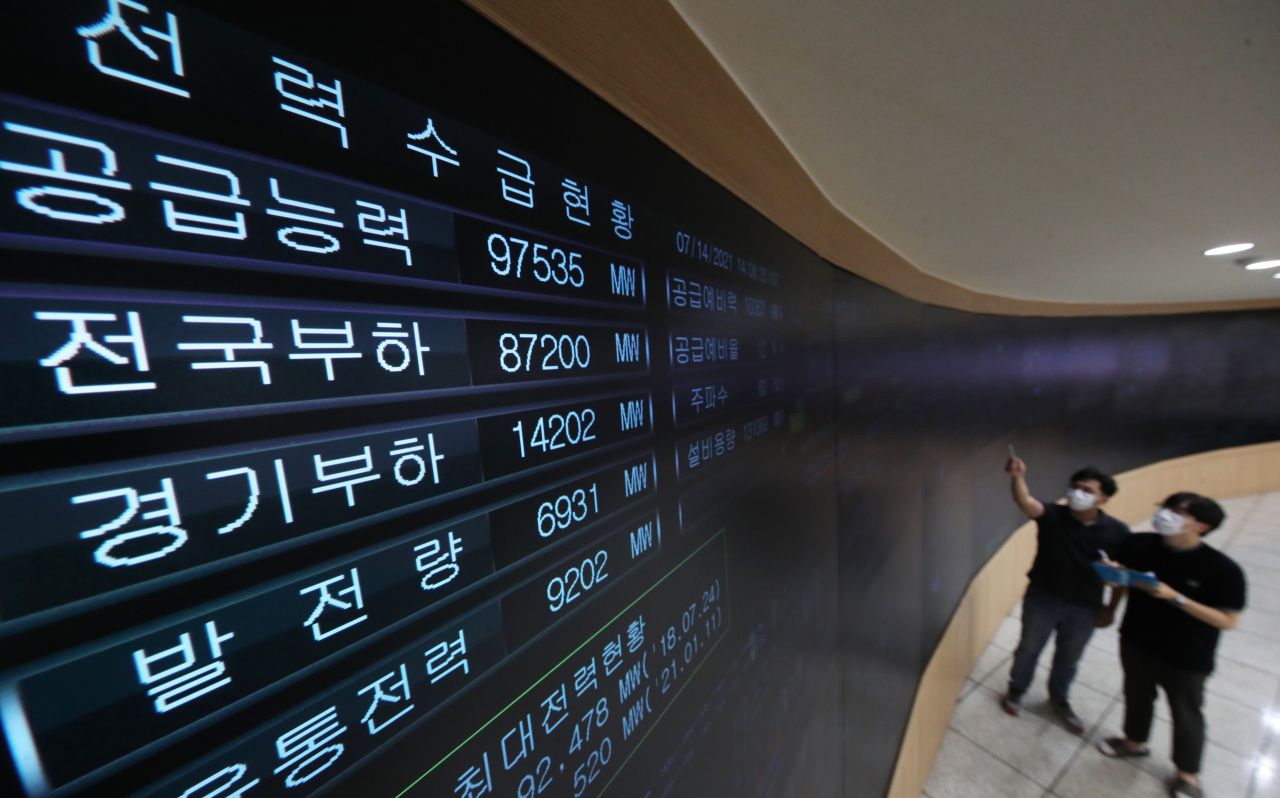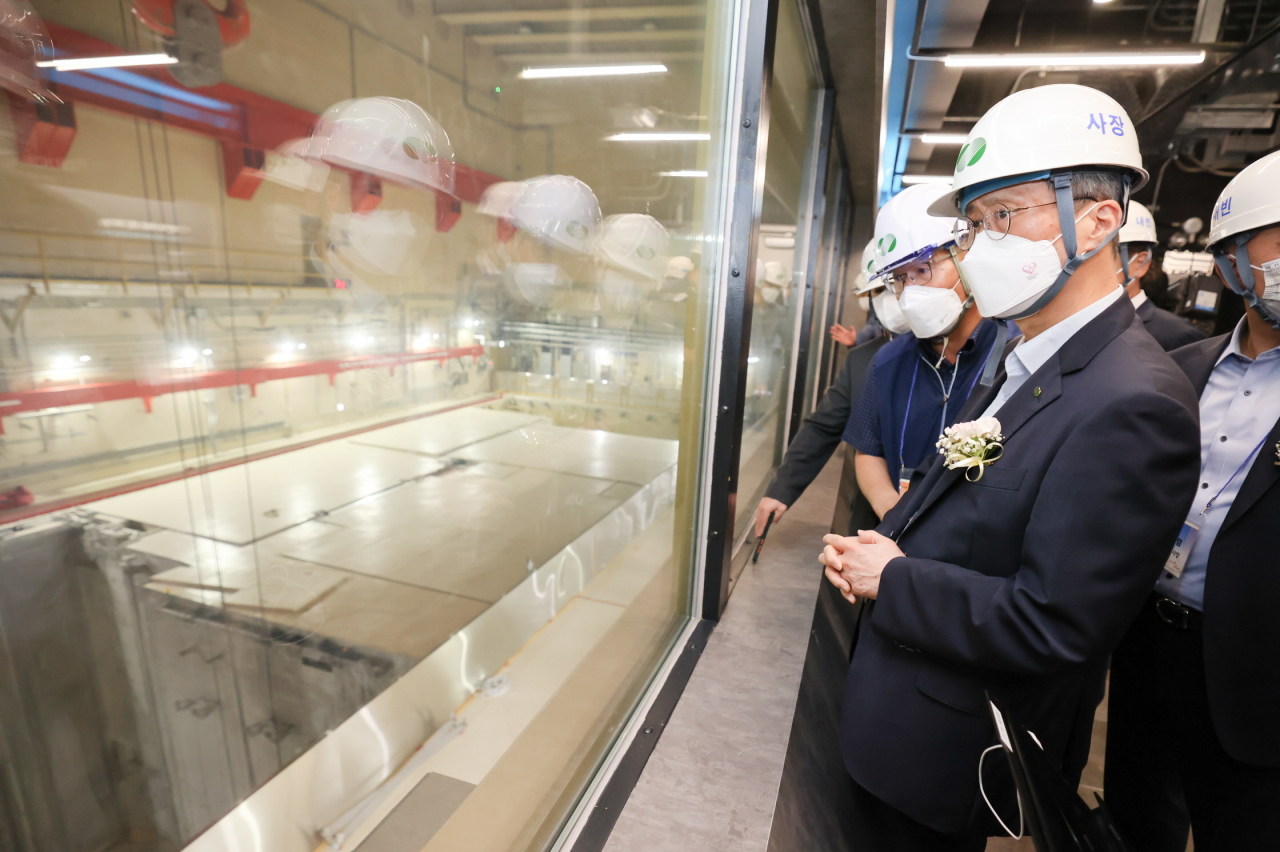 |
Staffers at Kepco’s branch in Suwon, Gyeonggi Province, looks at the screen to check the changes in the demand and supply of electricity. (Yonhap) |
Alarm bells are ringing over power security this summer, as the heat wave has driven electricity demand to historic highs already before August, the hottest month of summer, arrives.
The electricity reserve margin, the difference between the supply capacity and demand, fell close to 10 percent last week, recording the season’s lowest 10.1 percent on Tuesday, with the remaining supply capacity dipping to 8.8 gigawatts.
A reserve ratio under 10 percent, or a remaining capacity under 10 GW, is considered “unusual.”
Last summer, the 10 GW threshold was first breached on Aug. 25.
“The government should feel a sense of crisis,” said professor Huh Sung-yoon from Seoul National University of Science & Technology’s department of Energy Policy.
“We haven’t even gotten to the hottest months of the year, but the reserve margin has dropped to (near) 10 percent. The government said earlier it could drop to single digits. We cannot rule out the possibility of a blackout.”
This week could be even more challenging, according to weather forecasts from the National Weather Agency. Temperatures are expected to reach up to 34 degrees Celsius. This surpasses the daily peaks last week when electricity demand posted record-breaking highs and reserve margin rates were down to 10.1 percent.
The Ministry of Industry admitted the situation was concerning and said electricity demand could go up to 94 GW in the fourth week of July. This could bring the reserve margin rate down to an alarming 4.2 percent, or a reserve capacity of 4 GW.
If that forecast is right, an alert on power shortages will be issued for the first time in eight years after August 2013. When the reserve falls below 5.5 GW, authorities issue the warning and implement emergency measures to avert a blackout.
 |
KHNP President and CEO Chung Jae-hoon and other staffers check a nuclear reactor facility on Wednesday. (Yonhap) |
South Korea experienced a massive blackout in September 2011 when power was cut off from 7.5 million households and recorded 6.2 billion won ($5.43 million) in losses due to businesses and factories having to shut down.
Some experts argued President Moon Jae-in’s nuclear phase-out policy had had, to some extent, an effect on the looming power crisis. Too many nuclear reactors were shut down over the years, and renewable energy and fossil fuel were not enough to allow a stable management of power supply, they claimed.
“The average operation rate of nuclear reactors has dropped significantly during this administration. Reactors used to work at 90 to 95 percent of its full capacity. Now it’s far below that. I think this is the cause of the power shortage,” said Lee You-ho, an assistant professor at Seoul National University’s Department of Nuclear System Engineering.
Once operating at over 90 percent, the average operation rate of the nation’s nuclear power plants has continued to head south over the past three years. It remained between 60 to 75 percent since 2018, according to data from the Korea Hydro & Nuclear Power.
Similarly, on Wednesday and Thursday -- when the reserve margin rate neared 10 percent -- the average operation rate of nuclear power plants was at 64.6 and 64.5, respectively.
“There are benefits to expanding renewable energy. But they cannot be a reliable source of power because when there is no wind or sunlight we can’t produce electricity. I think the power crunch happening now, is indicative of problems in the (government’s) nuclear phase-out policy,” said Lee from Seoul National University.
As concerns grow, the government said it will give financial incentives to businesses that shuts down factories and cut power usage in a bid to prevent electricity demand from growing further.
Other experts say curbing demand is not going to solve the problem. Demand for electricity will only grow further, they say, with global warming and technological developments.
“Curbing demand could be in the right direction to shift the paradigm of the government’s energy policy. But, producing enough energy supply is equally important. Demand will obviously grow in the future, so the government should reassess whether the existing infrastructures are capable of meeting that demand,” said professor Huh.
By Kang Jae-eun (
kang.jaeeun@heraldcorp.com)









